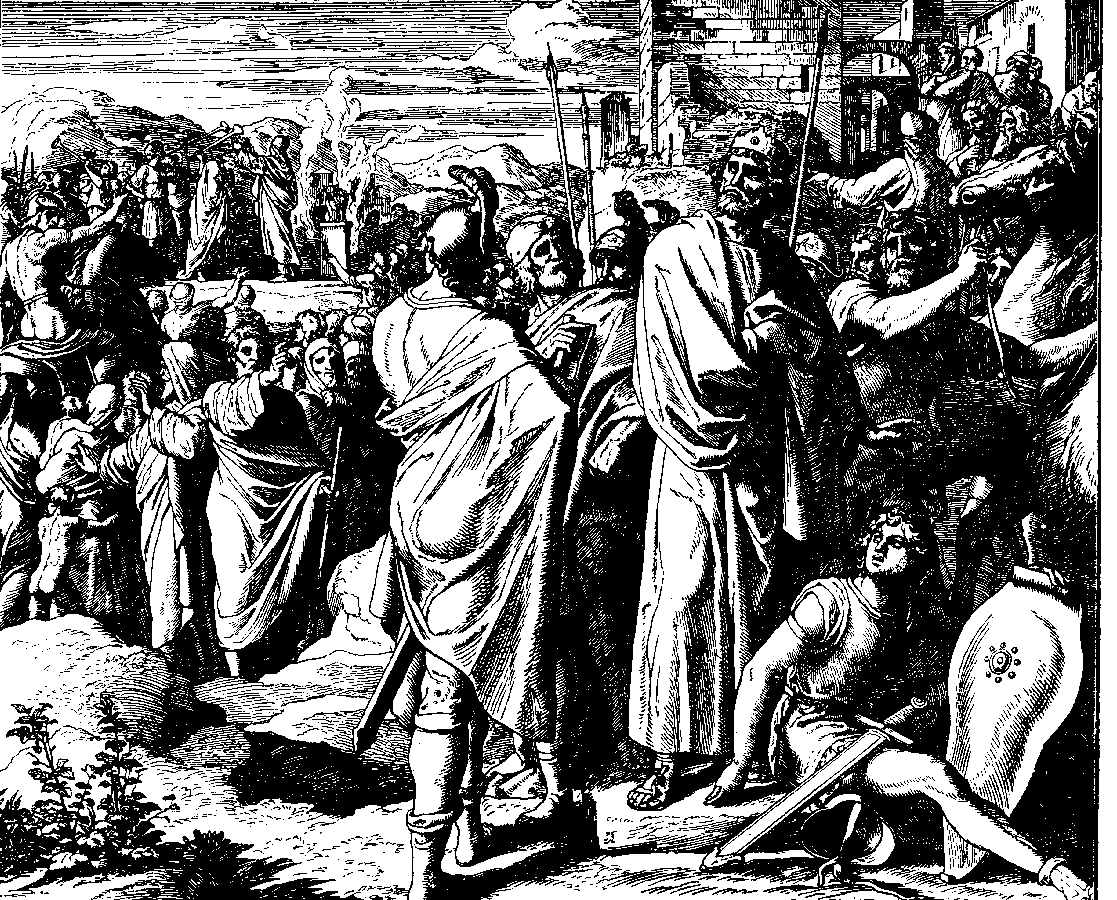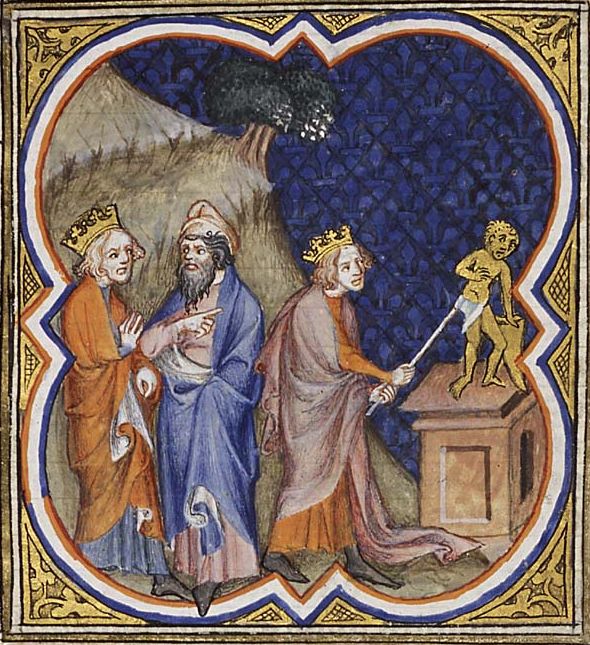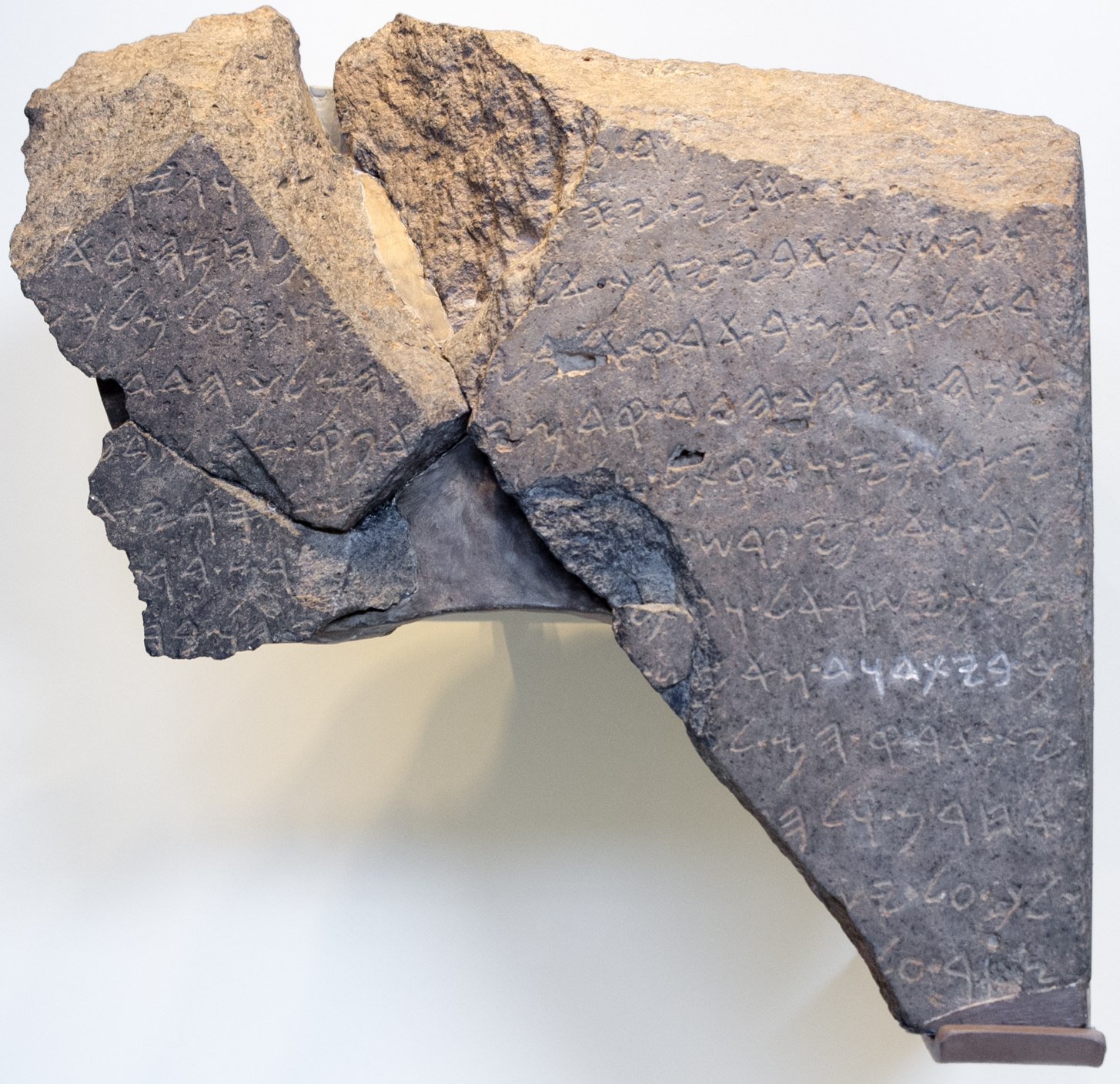|
Oded (father Of Azariah)
Oded is a figure in the Hebrew Bible mentioned in 2 Chronicles 15. He is mentioned in verse 1 as the father of Azariah the prophet, whose speech to King Asa of Judah initiates reforms in the religious life of the kingdom of Judah. The Masoretic Text omits Azariah's name in verse 8, suggesting that the prophecy is from Oded himself, but the Syriac version, the Latin Vulgate and modern translations like the New International Version refer to "Azariah the son of Oded" in this verse. The third century BCE Septuagint translation has Ὠδήδ (''Oded'') in verse 1 but Ἀδὰδ (''Adad'') in verse 8. In the Talmud The Talmud (; ) is the central text of Rabbinic Judaism and the primary source of Jewish religious law (''halakha'') and Jewish theology. Until the advent of Haskalah#Effects, modernity, in nearly all Jewish communities, the Talmud was the cen ..., Oded is also listed as a prophet. A different Oded is mentioned in 2 Chronicles 28. References {{reflist 10th-cen ... [...More Info...] [...Related Items...] OR: [Wikipedia] [Google] [Baidu] |
Hebrew Bible
The Hebrew Bible or Tanakh (;"Tanach" . '' Random House Webster's Unabridged Dictionary''. ; ; or ), also known in Hebrew as (; ), is the canonical collection of scriptures, comprising the Torah (the five Books of Moses), the Nevi'im (the Books of the Prophets), and the [...More Info...] [...Related Items...] OR: [Wikipedia] [Google] [Baidu] |
2 Chronicles
The Book of Chronicles ( , "words of the days") is a book in the Hebrew Bible, found as two books (1–2 Chronicles) in the Christian Old Testament. Chronicles is the final book of the Hebrew Bible, concluding the third section of the Jewish Tanakh, the Ketuvim ("Writings"). It contains a genealogy starting with Adam and a history of ancient Judah and Israel up to the Edict of Cyrus in 539 BC. The book was translated into Greek and divided into two books in the Septuagint in the mid-3rd century BC. In Christian contexts Chronicles is referred to in the plural as the Books of Chronicles, after the Latin name given to the text by Jerome, but is also referred to by its Greek name as the Books of Paralipomenon. In Christian Bibles, they usually follow the two Books of Kings and precede Ezra–Nehemiah, the last history-oriented book of the Protestant Old Testament. Summary The Chronicles narrative begins with Adam, Seth and Enosh, and the story is then carried forward, almost e ... [...More Info...] [...Related Items...] OR: [Wikipedia] [Google] [Baidu] |
Azariah (prophet)
Azariah ( , " Yah has helped") was a prophet described in 2 Chronicles 15. Biblical narrative The Spirit of God is described as coming upon him (verse 1), and he goes to meet King Asa of Judah to exhort him to carry out a work of reform. In response to Azariah's encouragement, Asa carried out a number of reforms including the destruction of idols and repairs to the altar of Yahweh in the Jerusalem Temple complex. The Bible records that a period of peace followed the carrying out of these reforms (verse 19). Azariah is described as being the "son of Oded" (verse 1), but the Masoretic Text The Masoretic Text (MT or 𝕸; ) is the authoritative Hebrew and Aramaic text of the 24 books of the Hebrew Bible (''Tanakh'') in Rabbinic Judaism. The Masoretic Text defines the Jewish canon and its precise letter-text, with its vocaliz ... omits Azariah's name in verse 8, suggesting that the prophecy is from Oded himself. References Prophets in the Hebrew Bible Books ... [...More Info...] [...Related Items...] OR: [Wikipedia] [Google] [Baidu] |
Asa Of Judah
Asa (; ; ; ) was, according to the Hebrew Bible, the third king of the Kingdom of Judah and the fifth king of the Davidic line, House of David. Based on the Biblical chronology, Biblical scholars suggest that he reigned from the late 10th to early 9th century BCE. He was succeeded by Jehoshaphat, his son (by Azubah (mother of Jehoshaphat), Azubah). According to Edwin R. Thiele's chronology, when Asa became very ill, he made Jehoshaphat coregent. Asa died two years into the coregency. Asa son of Abijah was zealous in maintaining the traditional worship of God, and in rooting out idolatry, with its accompanying immoralities. After concluding a battle with Zerah of Ethiopia in the 10th year of his reign, there was peace in Judah () until the 36th year of Asa's reign (). In his 36th year, he was confronted by Baasha of Israel, Baasha, king of Kingdom of Israel (Samaria), Israel. He formed an alliance with Ben-Hadad I, king of Aram Damascus, Aram-Damascus, and using a monetary bribe, c ... [...More Info...] [...Related Items...] OR: [Wikipedia] [Google] [Baidu] |
Kingdom Of Judah
The Kingdom of Judah was an Israelites, Israelite kingdom of the Southern Levant during the Iron Age. Centered in the highlands to the west of the Dead Sea, the kingdom's capital was Jerusalem. It was ruled by the Davidic line for four centuries. Jews are named after Judah, and primarily descend from people who lived in the region. The Hebrew Bible depicts the Kingdom of Judah as one of the two successor states of the Kingdom of Israel (united monarchy), United Kingdom of Israel, a term denoting the united monarchy under biblical kings Saul, David, and Solomon and covering the territory of Judah and Kingdom of Israel (Samaria), Israel. However, during the 1980s, Biblical minimalism, some biblical scholars began to argue that the archaeological evidence for an extensive kingdom before the late 8th century BCE is too weak, and that the methodology used to obtain the evidence is flawed. In the 10th and early 9th centuries BCE, the territory of Judah might have been limited ... [...More Info...] [...Related Items...] OR: [Wikipedia] [Google] [Baidu] |
Masoretic Text
The Masoretic Text (MT or 𝕸; ) is the authoritative Hebrew and Aramaic text of the 24 books of the Hebrew Bible (''Tanakh'') in Rabbinic Judaism. The Masoretic Text defines the Jewish canon and its precise letter-text, with its vocalization and accentuation known as the ''masora''. Referring to the Masoretic Text, ''masora'' specifically means the diacritic markings of the text of the Jewish scriptures and the concise marginal notes in manuscripts (and later printings) of the Tanakh which note textual details, usually about the precise spelling of words. It was primarily copied, edited, and distributed by a group of Jews known as the Masoretes between the 7th and 10th centuries of the Common Era (CE). The oldest known complete copy, the Leningrad Codex, dates to 1009 CE and is recognized as the most complete source of biblical books in the Ben Asher tradition. It has served as the base text for critical editions such as Biblia Hebraica Stuttgartensia and Adi. The d ... [...More Info...] [...Related Items...] OR: [Wikipedia] [Google] [Baidu] |
Syriac Versions Of The Bible
Syriac is a dialect of Aramaic. Portions of the Old Testament were written in Aramaic and there are Aramaic phrases in the New Testament. Syriac translations of the New Testament were among the first and date from the 2nd century. The whole Bible was translated by the 5th century. Besides Syriac, there are Bible translations into other Aramaic dialects. Syria played an important or even predominant role in the beginning of Christianity. Here is where the Gospel of Matthew, the Gospel of Luke, the Didache, Ignatiana, and the Gospel of Thomas are believed to have been written. Syria was the country in which the Greek language intersected with the Syriac, which was closely related to the Aramaic dialect used by Jesus and the Apostles. That is why Syriac versions are highly esteemed by textual critics. Scholars have distinguished five or six different Syriac versions of all or part of the New Testament. It is possible that some translations have been lost. Other than Syria, the ma ... [...More Info...] [...Related Items...] OR: [Wikipedia] [Google] [Baidu] |
Vulgate
The Vulgate () is a late-4th-century Bible translations into Latin, Latin translation of the Bible. It is largely the work of Saint Jerome who, in 382, had been commissioned by Pope Damasus I to revise the Gospels used by the Diocese of Rome, Roman Church. Later, of his own initiative, Jerome extended this work of revision and translation to include most of the books of the Bible. The Vulgate became progressively adopted as the Bible text within the Western Church. Over succeeding centuries, it eventually eclipsed the texts. By the 13th century it had taken over from the former version the designation (the "version commonly used") or for short. The Vulgate also contains some ''Vetus Latina'' translations that Jerome did not work on. The Catholic Church affirmed the Vulgate as its official Latin Bible at the Council of Trent (1545–1563), though there was no single authoritative edition of the book at that time in any language. The Vulgate did eventually receiv ... [...More Info...] [...Related Items...] OR: [Wikipedia] [Google] [Baidu] |
New International Version
The New International Version (NIV) is a translation of the Bible into contemporary English. Published by Biblica, the complete NIV was released on October 27, 1978, with a minor revision in 1984 and a major revision in 2011. The NIV relies on recently published critical editions of the original Hebrew, Aramaic, and Greek texts. Biblica claims that "the NIV delivers the very best combination of accuracy and readability." As of March 2013, over 450 million printed copies of the translation had been distributed. The NIV is the best-selling translation in the United States. History Beginnings In 1955, businessman Howard Long was convinced of the need for a contemporary English translation of the Bible while sharing the gospel with a business associate. He was unhappy with the King James Version that he used to communicate the gospel and was frustrated with its archaic language. He thought, "Everywhere I go, in Canada, the U.S., anywhere, there are people who would like to re ... [...More Info...] [...Related Items...] OR: [Wikipedia] [Google] [Baidu] |
Septuagint
The Septuagint ( ), sometimes referred to as the Greek Old Testament or The Translation of the Seventy (), and abbreviated as LXX, is the earliest extant Greek translation of the Hebrew Bible from the original Biblical Hebrew. The full Greek title derives from the story recorded in the Letter of Aristeas to Philocrates that "the laws of the Jews" were translated into Koine Greek, the Greek language at the request of Ptolemy II Philadelphus (285–247 BC) by seventy-two Hebrew sofer, translators—six from each of the Twelve Tribes of Israel.Megillah (Talmud), Tractate Megillah 9](9a)/ref>Soferim (Talmud), Tractate Soferim 1](1:7-8)/ref> Textual criticism, Biblical scholars agree that the Torah, first five books of the Hebrew Bible were translated from Biblical Hebrew into Koine Greek by Jews living in the Ptolemaic Kingdom, centred on the History of the Jews in Alexandria, large community in Alexandria, probably in the early or middle part of the 3rd century BC. The remainin ... [...More Info...] [...Related Items...] OR: [Wikipedia] [Google] [Baidu] |
Talmud
The Talmud (; ) is the central text of Rabbinic Judaism and the primary source of Jewish religious law (''halakha'') and Jewish theology. Until the advent of Haskalah#Effects, modernity, in nearly all Jewish communities, the Talmud was the centerpiece of Jewish culture, Jewish cultural life and was foundational to "all Jewish thought and aspirations", serving also as "the guide for the daily life" of Jews. The Talmud includes the teachings and opinions of thousands of rabbis on a variety of subjects, including halakha, Jewish ethics, Jewish philosophy, philosophy, Jewish customs, customs, Jewish history, history, and Jewish folklore, folklore, and many other topics. The Talmud is a commentary on the Mishnah. This text is made up of 63 Masekhet, tractates, each covering one subject area. The language of the Talmud is Jewish Babylonian Aramaic. Talmudic tradition emerged and was compiled between the destruction of the Second Temple in 70 CE and the Arab conquest in the early seve ... [...More Info...] [...Related Items...] OR: [Wikipedia] [Google] [Baidu] |
Oded (prophet)
Oded ( ''‘Ōḏêḏ'') is a prophet in the Hebrew Bible, mentioned in 2 Chronicles 28. He was from Samaria, and met the army of the northern kingdom of Israel, who were returning with captives from Judah. In a speech from verse 9 to verse 11, he urged them to return the slaves. He was joined in this plea by some of the northern kingdom's leaders (verses 12-13), and it was successful. The slaves were escorted back to Jericho (verse 15) after being clothed, fed, anointed and some of them put on donkeys. The leaders, certain chiefs of the Ephraimites, were Azariah son of Johanan, Berechiah son of Meshillemoth, Jehizkiah son of Shallum, and Amasa son of Hadlai, who said, “You shall not bring the captives in here, for you propose to bring on us guilt against the Lord in addition to our present sins and guilt. For our guilt is already great, and there is fierce wrath against Israel.” This episode has been compared to the story of the Good Samaritan. William Schniedewind notes ... [...More Info...] [...Related Items...] OR: [Wikipedia] [Google] [Baidu] |






